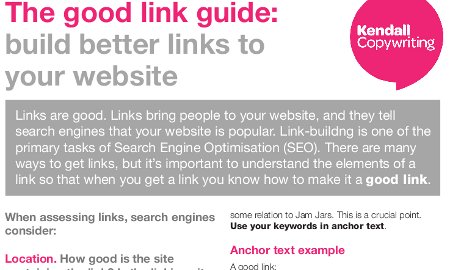Okay, so this title could be a little misleading.
Yes, there are simple steps you can take to improve your website’s search engine performance, but they usually take some time, thought and persistence to pull off.
But first, let’s look at why you might want to improve how well your website performs in searches:
- The majority of web traffic is conducted via search engines.
- If you want to be found, you need to be on the first page for relevant searches.
- In-bound leads are easier to convert than out-bound leads.
It’s a no-brainer. You can either take your share of the most lucrative leads, or you can leave them to your competitors, while you struggle to persuade sceptical prospects on your long list.
Search engine optimisation consists of three strands of activity:
- Structural and technical search engine optimisation
- Content optimisation
- Offsite link building activities
Structural and technical search engine optimisation
In simple terms, this means making sure that your website is coded in a way that Google can interpret. You want to be sure that Google can scan your entire website.
Google wants to recommend the best and most relevant websites for every search query. So in addition to creating good content, you need to be sure that your website is also:
- Secure – with HTTPS enabled. Google prefers sites that use this secure web standard.
- Slow websites are less likely to be recommended. You can test the mobile speed of your website with Google’s Test My Site app [https://www.thinkwithgoogle.com/intl/en-gb/feature/testmysite/]
- Web designs that adapt to any screen size are typically faster to load than their unresponsive counterparts.
Page organisation and breadcrumbs
Creating a well-organised website can also help Google make sense of your business – and understand which pages are most important.
Make sure that your pages are logically nested (e.g. www.yoursite.com/products/lawnmowers/MegaCut3000)
Hidden content
Is any of your content hidden from Google?
You might have pages that can only be accessed using searches or through filtering, which Google cannot see.
Check that Google can see all of the content that you want them to find.
Content optimisation
What does it mean to optimise your content?
It means to look at every word, image and video on your website through the lens of a search engine.
Google uses software to ‘read’ your website. While humans have the ability to read between the lines, correct your mistakes and patiently sift through your waffle, the search engine software can only interpret the words you include.
Ultimately, your entire website should be reviewed so that important elements include relevant keywords.
Important elements of your website include:
- Page titles (an HTML element that appears at the top of the browser tab)
- Page descriptions (an HTML element that appears in search results pages)
- Headings (using the HTML elements H1,H2,H3 in a logical order)
- Body copy
- Links
As well as adding keywords to your page titles, descriptions, headings, body copy and links, you should ensure all of these elements are front-loaded with the most important details. This means putting the key details first so they catch a customer’s eye.
For example: “Cases and accessories for iPads” would be better (in most cases) as “iPad cases and accessories”.
Keywords – choosing the optimal search terms
Which words do people use when they’re searching for a business like yours?
Let’s imagine you make pens.
You don’t stand much of a chance of appearing on the first page of Google for ‘pens’.
This is true for many business cases. If your business niche is at all competitive, you will likely struggle to dominate the search results without a major effort.
However, there is a simple solution to this conundrum.
Instead of targeting the most competitive keywords, you start with less popular queries, such as:
- Retractable recycled pens
- Pens with penguins
- Pens made of cardboard
This approach can be used for any business. For a freelance copywriter, you would target specific niches, such as:
- Freelance digital copywriter
- Freelance copywriter Poole
- Freelance web copywriter Dorset
For a software company, the examples might be:
- Custom industrial software development
- Cloud communications software consultancy
- Bespoke software developers B2B
While the traffic for these niche search queries is undoubtedly far less than their mainstream counterparts, they offer two advantages:
- You stand a chance of appearing on the first page for a niche query. Being seen means being found – and that means a chance of making a sale.
- These long-tail queries may represent more active buyers. After all, who goes looking for a “cloud communications software consultancy” unless they need the help of one? A significant percentage of the huge search volumes for general queries may represent researchers, tyre-kickers and competitors – not buyers.
Consider synonyms and regional keyword variations
A common mistake with keywords is to focus on the wrong terms. When it comes to search engine optimisation, we must put aside personal preferences and use data to guide our decisions.
You might call your main product a widgette, but everyone else calls it a widget. You might be factually correct, but you’re actually wrong, because in SEO the market and the majority define reality.
You can use the Google Keyword Planner to check the search volumes of different keywords – and to get additional keyword ideas.
You want to know which keywords capture the most searches, but as we discussed above, it’s worth looking at less popular searches because you may be able to land on the first page for these long-tail search phrases.
Offsite link-building
Google assumes that every time another website links to yours, they are suggesting you have something of value. Links are like a vote of confidence. More links = better websites – at least in the eyes of Google.
This is why business owners go to great lengths to get other sites to link to theirs. These links – or backlinks as they are known – are hugely valuable in the battle for traffic.
In simple terms, there are two categories of backlink-building strategies that I advocate:
- Creating significant content or resources that others will want to share
- Taking advantage of natural link opportunities (directories, community initiatives etc)
Let’s examine these two ideas in a little more detail.
Create significant resources or content
This approach is not quick or easy, but it does help you build genuine connections within your industry. This can take many forms, and is only really limited by your imagination and your capacity. Examples include:
- Surveys
- Guides
- Whitepapers
- Calculators
- Contracts
- Templates
- Reports
- Analysis
- Events and conferences
- Meetups
- Interviews
- Podcasts
- Research groups
- Webinars
- Tutorials
- Lists
Take advantage of natural link opportunities
There are loads of easy links available:
- Business directories
- Professional associations
- Location-based listings
- Local groups
- Social media
- Comments and forum posts
- Contributed articles and guest posts
- Interviews with peers
Quick SEO wins you can implement today
There are three simple things that you can do to improve your search engine optimisation today:
- Update your website title
- Fix blog post titles
- Publish one massive blog post that perfectly addresses a key search query
1: Update your website title
One of the biggest mistakes I see companies make is to put pride before profit and use their website and page title to repeat their company name – instead of telling people what they offer.
Your page titles are a vital SEO asset. They tell Google what’s important on your site. If you use this space to highlight your company name, you aren’t giving Google any additional clues; you’re only going to improve your chances of appearing in searches for your company name.
If you only want to be found by people who already know about you, then carry on. But if you want to find new customers, then you need to make better use of your page titles.
For example, if you were selling stereo equipment, the following page title would be a huge missed opportunity:
Davidson’s HiFi | The best independent store for audiophiles in the southwest
Far better to focus on the keywords that people use to find a store like yours:
Stereo Equipment | Home Cinema | TV | Davidson’s HiFi
Here’s another bad example:
Hunt, McDermitt & Simon | Dorset
This firm of solicitors may as well don camouflage and lurk in some bushes. Again, it’s far better to use the page titles to focus on the keywords that people use in searches:
Solicitors in Poole | Conveyancing | Family Law | Hunt McDermitt & Simon
2: Fix blog post titles
Not every blog post is designed to be found. Some articles are ‘of the moment’ or just a commentary on something short-lived.
But when you write articles that are designed to be helpful, then you should make sure that the titles are descriptive and specific enough to be picked up by search engines.
Let’s look at some bad examples of blog post titles and how they can be improved:
Removing dust
This doesn’t tell us much about the environment or the specifics. It’s unlikely to be returned in search results because it is far too vague. A better title would be something like:
Removing dust from electronic equipment safely and effectively
Or
How to remove dust using cleaners and products you have in your home
Or even
How to remove dust in your home if you have allergies
Choosing a development partner
This also fails to explain the specifics. The authors have assumed, rightly, that the people on their blog know what kind of development they mean. But when this content is divorced from the blog, and thrust into the sea of blog posts, it means nothing, and is unlikely to appear in many search results.
A better title would be more specific:
Choosing a development partner for your bespoke software
Or
How to choose a software development partner for your communications company
3: Publish one massive blog post that answers an important search query
Perform a search for your most important keyword or key phrase. What do you see in the results?
While you may see some of your major competitors, you may also see smaller sites that have written blog posts addressing a common question relevant to the keyword.
Among your most important keywords, there may be questions that your business can answer. For example, if you sell wallpaper, you could write articles about how to compare different paper brands and types, or how to understand the terminology. If you sell design services, you could produce a guide to the different approaches that design agencies take – either from a service delivery perspective or in terms of design ethos.
Any suggestions?
I hope you’ve found this interesting. Have you got any top tips of your own? What have you found helpful in optimising for search engines? Please comment below.








